Child and Adolescence Healthcare
VerifiedAdded on 2023/06/14
|11
|2677
|349
AI Summary
This paper discusses the pathophysiology of a 14-year-old aboriginal girl with ARF/RHD, the roles of nurses, growth and developmental theories, family-centered care, and the effects of hospitalization on the child.
Contribute Materials
Your contribution can guide someone’s learning journey. Share your
documents today.
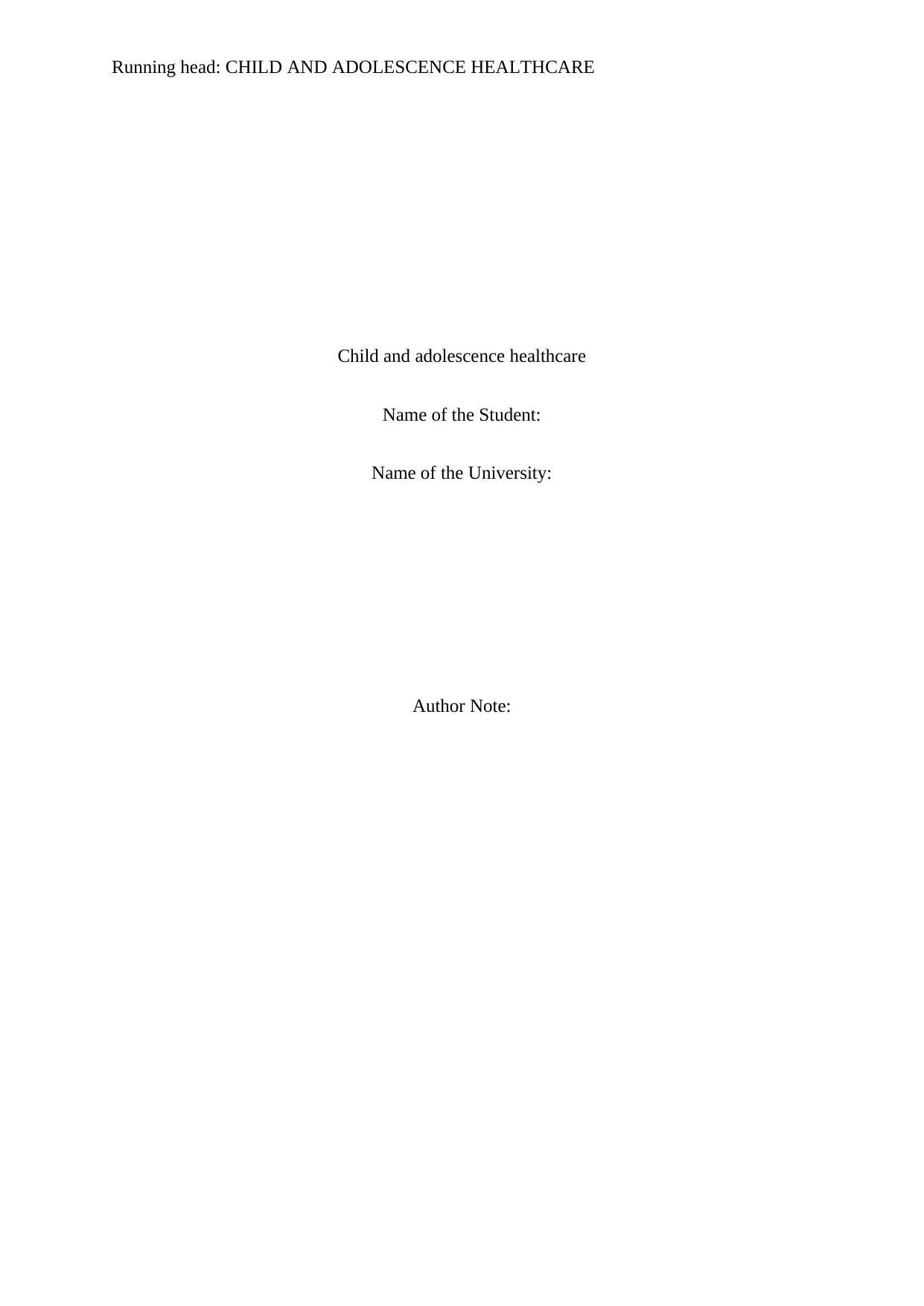
Running head: CHILD AND ADOLESCENCE HEALTHCARE
Child and adolescence healthcare
Name of the Student:
Name of the University:
Author Note:
Child and adolescence healthcare
Name of the Student:
Name of the University:
Author Note:
Secure Best Marks with AI Grader
Need help grading? Try our AI Grader for instant feedback on your assignments.
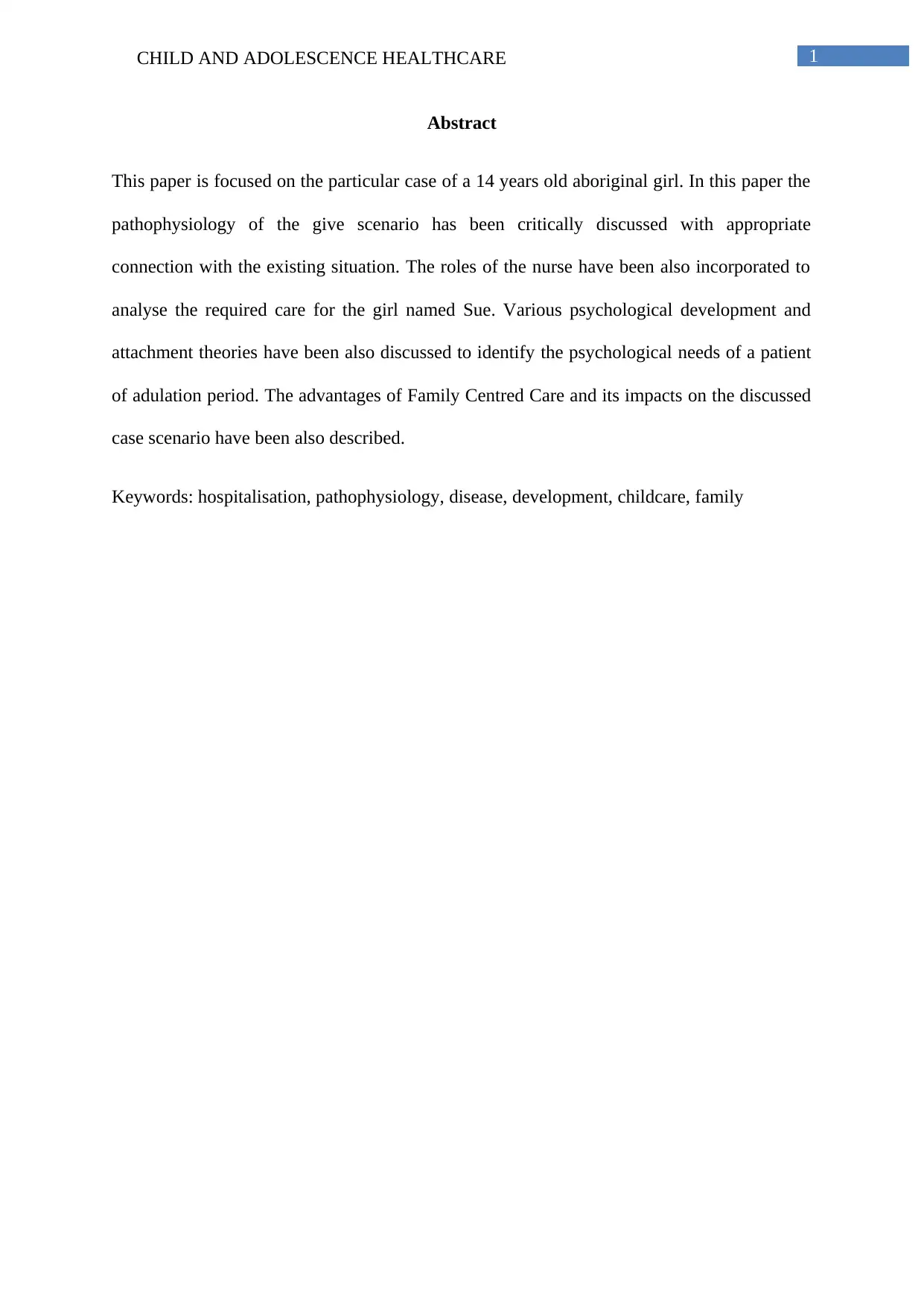
1CHILD AND ADOLESCENCE HEALTHCARE
Abstract
This paper is focused on the particular case of a 14 years old aboriginal girl. In this paper the
pathophysiology of the give scenario has been critically discussed with appropriate
connection with the existing situation. The roles of the nurse have been also incorporated to
analyse the required care for the girl named Sue. Various psychological development and
attachment theories have been also discussed to identify the psychological needs of a patient
of adulation period. The advantages of Family Centred Care and its impacts on the discussed
case scenario have been also described.
Keywords: hospitalisation, pathophysiology, disease, development, childcare, family
Abstract
This paper is focused on the particular case of a 14 years old aboriginal girl. In this paper the
pathophysiology of the give scenario has been critically discussed with appropriate
connection with the existing situation. The roles of the nurse have been also incorporated to
analyse the required care for the girl named Sue. Various psychological development and
attachment theories have been also discussed to identify the psychological needs of a patient
of adulation period. The advantages of Family Centred Care and its impacts on the discussed
case scenario have been also described.
Keywords: hospitalisation, pathophysiology, disease, development, childcare, family
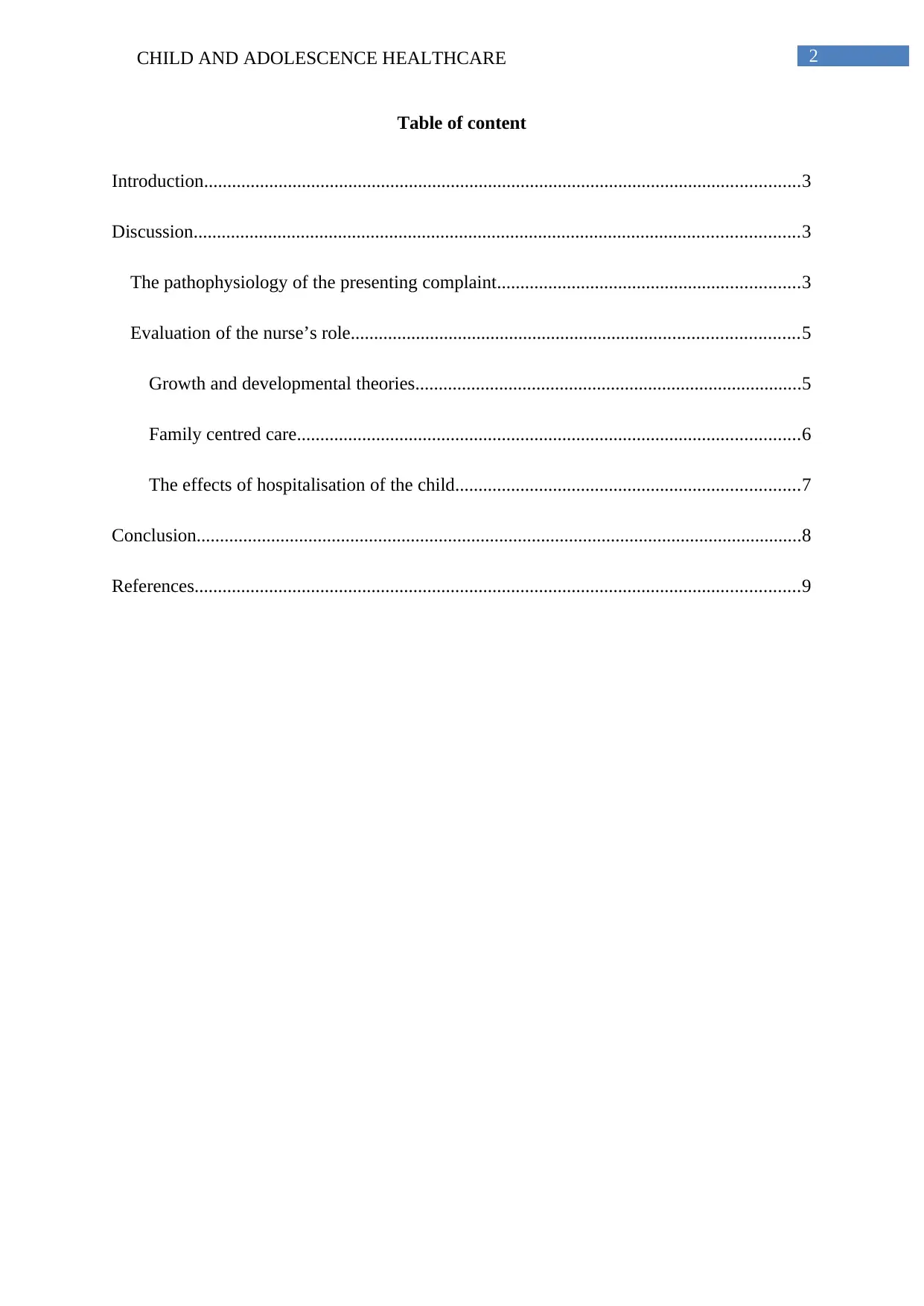
2CHILD AND ADOLESCENCE HEALTHCARE
Table of content
Introduction................................................................................................................................3
Discussion..................................................................................................................................3
The pathophysiology of the presenting complaint.................................................................3
Evaluation of the nurse’s role................................................................................................5
Growth and developmental theories...................................................................................5
Family centred care............................................................................................................6
The effects of hospitalisation of the child..........................................................................7
Conclusion..................................................................................................................................8
References..................................................................................................................................9
Table of content
Introduction................................................................................................................................3
Discussion..................................................................................................................................3
The pathophysiology of the presenting complaint.................................................................3
Evaluation of the nurse’s role................................................................................................5
Growth and developmental theories...................................................................................5
Family centred care............................................................................................................6
The effects of hospitalisation of the child..........................................................................7
Conclusion..................................................................................................................................8
References..................................................................................................................................9
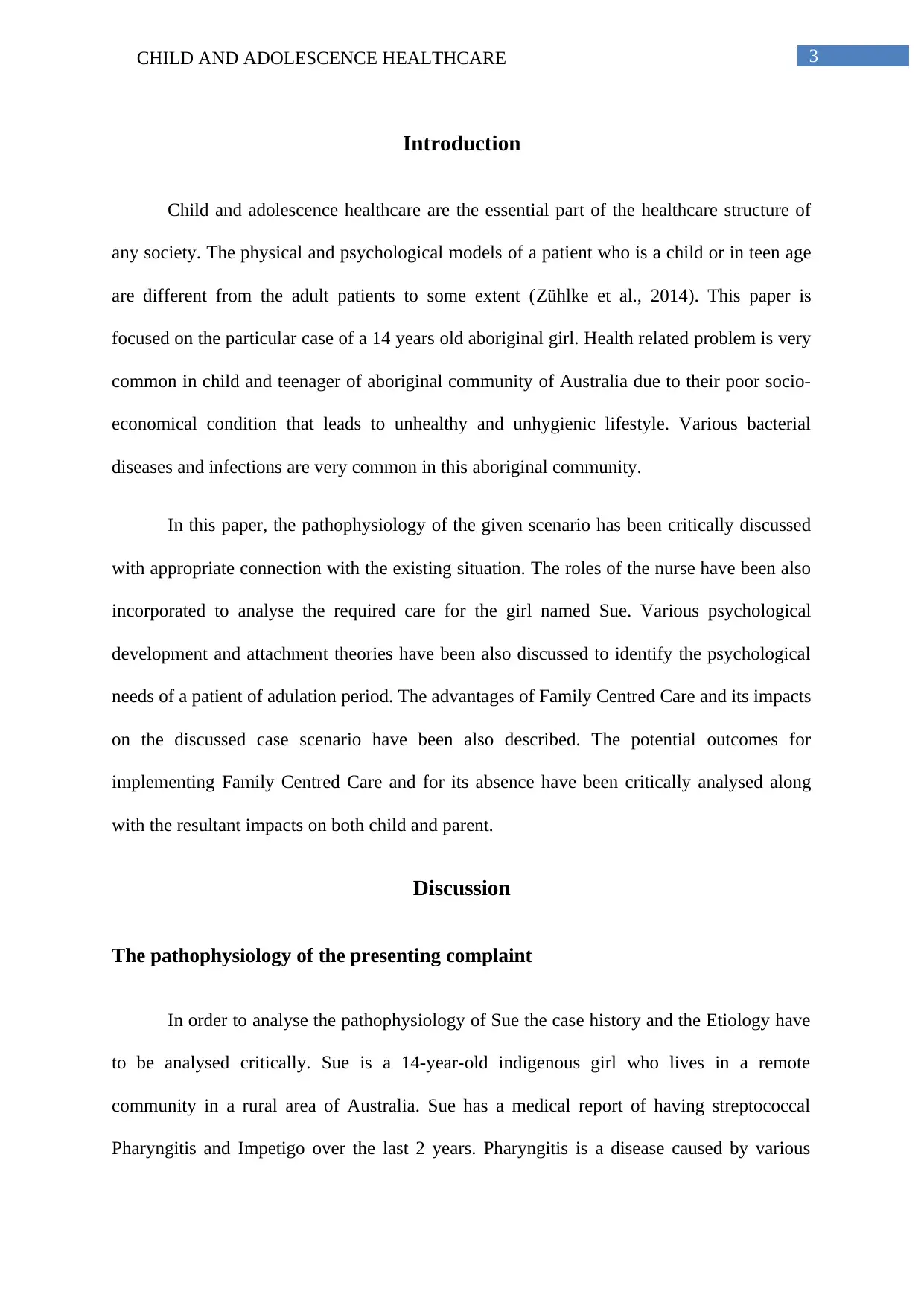
3CHILD AND ADOLESCENCE HEALTHCARE
Introduction
Child and adolescence healthcare are the essential part of the healthcare structure of
any society. The physical and psychological models of a patient who is a child or in teen age
are different from the adult patients to some extent (Zühlke et al., 2014). This paper is
focused on the particular case of a 14 years old aboriginal girl. Health related problem is very
common in child and teenager of aboriginal community of Australia due to their poor socio-
economical condition that leads to unhealthy and unhygienic lifestyle. Various bacterial
diseases and infections are very common in this aboriginal community.
In this paper, the pathophysiology of the given scenario has been critically discussed
with appropriate connection with the existing situation. The roles of the nurse have been also
incorporated to analyse the required care for the girl named Sue. Various psychological
development and attachment theories have been also discussed to identify the psychological
needs of a patient of adulation period. The advantages of Family Centred Care and its impacts
on the discussed case scenario have been also described. The potential outcomes for
implementing Family Centred Care and for its absence have been critically analysed along
with the resultant impacts on both child and parent.
Discussion
The pathophysiology of the presenting complaint
In order to analyse the pathophysiology of Sue the case history and the Etiology have
to be analysed critically. Sue is a 14-year-old indigenous girl who lives in a remote
community in a rural area of Australia. Sue has a medical report of having streptococcal
Pharyngitis and Impetigo over the last 2 years. Pharyngitis is a disease caused by various
Introduction
Child and adolescence healthcare are the essential part of the healthcare structure of
any society. The physical and psychological models of a patient who is a child or in teen age
are different from the adult patients to some extent (Zühlke et al., 2014). This paper is
focused on the particular case of a 14 years old aboriginal girl. Health related problem is very
common in child and teenager of aboriginal community of Australia due to their poor socio-
economical condition that leads to unhealthy and unhygienic lifestyle. Various bacterial
diseases and infections are very common in this aboriginal community.
In this paper, the pathophysiology of the given scenario has been critically discussed
with appropriate connection with the existing situation. The roles of the nurse have been also
incorporated to analyse the required care for the girl named Sue. Various psychological
development and attachment theories have been also discussed to identify the psychological
needs of a patient of adulation period. The advantages of Family Centred Care and its impacts
on the discussed case scenario have been also described. The potential outcomes for
implementing Family Centred Care and for its absence have been critically analysed along
with the resultant impacts on both child and parent.
Discussion
The pathophysiology of the presenting complaint
In order to analyse the pathophysiology of Sue the case history and the Etiology have
to be analysed critically. Sue is a 14-year-old indigenous girl who lives in a remote
community in a rural area of Australia. Sue has a medical report of having streptococcal
Pharyngitis and Impetigo over the last 2 years. Pharyngitis is a disease caused by various
Secure Best Marks with AI Grader
Need help grading? Try our AI Grader for instant feedback on your assignments.

4CHILD AND ADOLESCENCE HEALTHCARE
bacterial infections. Pharyngitis is usually caused by group A Streptococcus bacteria or as a
partial symptom of other bacterial diseases namely Gonorrhoea and Chlamydia. On the other
hand, Impetigo is a type of bacterial skin infection caused by either Staphylococcal or
Streptococcus bacteria. Impetigo can spread by the nasal discharge from another infected
person. Both of this can be treated with antibiotics (Kumar & Tandon, 2013).
Sue and her siblings are registered for a secondary prophylaxis program to avoid
chain spreading of bacteria. She receives Benzathine Penicillin G IM to reduce the risk of
ARF/RHD. ARF/RHD is a Rheumatic Heart disease main cause of expanded and untreated
bacterial infection. On the other hand, taking antibiotics is a regular and consistent process
without having any break or irregular pause. However, she has failed to receive IM
antibiotics. In this situation, the bacteria can spread again with adequate defence mechanism.
As a result, she has been experiencing sore throat from last 2 to 3 weeks with migratory joint
pains. Gradually, Sue was facing acute joint pain in her knees, elbows, ankles and shoulders
from last four days. She also had the body temperature of 38 degree Celsius which was
considerably high than normal body temperature. All of these symptoms can be caused either
overwhelmed infection by the bacteria or as a symptom of ARF/RHD. This fever is also
known as Acute Rheumatic Fever or ARF (Coyne, 2015).
Sue has been suspected of having Acute Rheumatic Fever. After being diagnosed by
the clinic medical officer Sue is referred to the hospital for further treatment in cardiology
and echocardiogram. ARF/RHD needs essential treatments focused on patients hygiene.
Regular high powered antibiotics intake orally or by injection can improve the conditions
caused by bacteria (Ralston et al., 2014). On the other hand, an additional cardiac internal
infection caused by disfigured antibodies also needs complete bed rest and adequate healthy
diet. Ignorance of this condition can be lethal due to its severe impact on cardiac tissues.
Hoverer, The closest hospital is situated at 800km away from her house.
bacterial infections. Pharyngitis is usually caused by group A Streptococcus bacteria or as a
partial symptom of other bacterial diseases namely Gonorrhoea and Chlamydia. On the other
hand, Impetigo is a type of bacterial skin infection caused by either Staphylococcal or
Streptococcus bacteria. Impetigo can spread by the nasal discharge from another infected
person. Both of this can be treated with antibiotics (Kumar & Tandon, 2013).
Sue and her siblings are registered for a secondary prophylaxis program to avoid
chain spreading of bacteria. She receives Benzathine Penicillin G IM to reduce the risk of
ARF/RHD. ARF/RHD is a Rheumatic Heart disease main cause of expanded and untreated
bacterial infection. On the other hand, taking antibiotics is a regular and consistent process
without having any break or irregular pause. However, she has failed to receive IM
antibiotics. In this situation, the bacteria can spread again with adequate defence mechanism.
As a result, she has been experiencing sore throat from last 2 to 3 weeks with migratory joint
pains. Gradually, Sue was facing acute joint pain in her knees, elbows, ankles and shoulders
from last four days. She also had the body temperature of 38 degree Celsius which was
considerably high than normal body temperature. All of these symptoms can be caused either
overwhelmed infection by the bacteria or as a symptom of ARF/RHD. This fever is also
known as Acute Rheumatic Fever or ARF (Coyne, 2015).
Sue has been suspected of having Acute Rheumatic Fever. After being diagnosed by
the clinic medical officer Sue is referred to the hospital for further treatment in cardiology
and echocardiogram. ARF/RHD needs essential treatments focused on patients hygiene.
Regular high powered antibiotics intake orally or by injection can improve the conditions
caused by bacteria (Ralston et al., 2014). On the other hand, an additional cardiac internal
infection caused by disfigured antibodies also needs complete bed rest and adequate healthy
diet. Ignorance of this condition can be lethal due to its severe impact on cardiac tissues.
Hoverer, The closest hospital is situated at 800km away from her house.
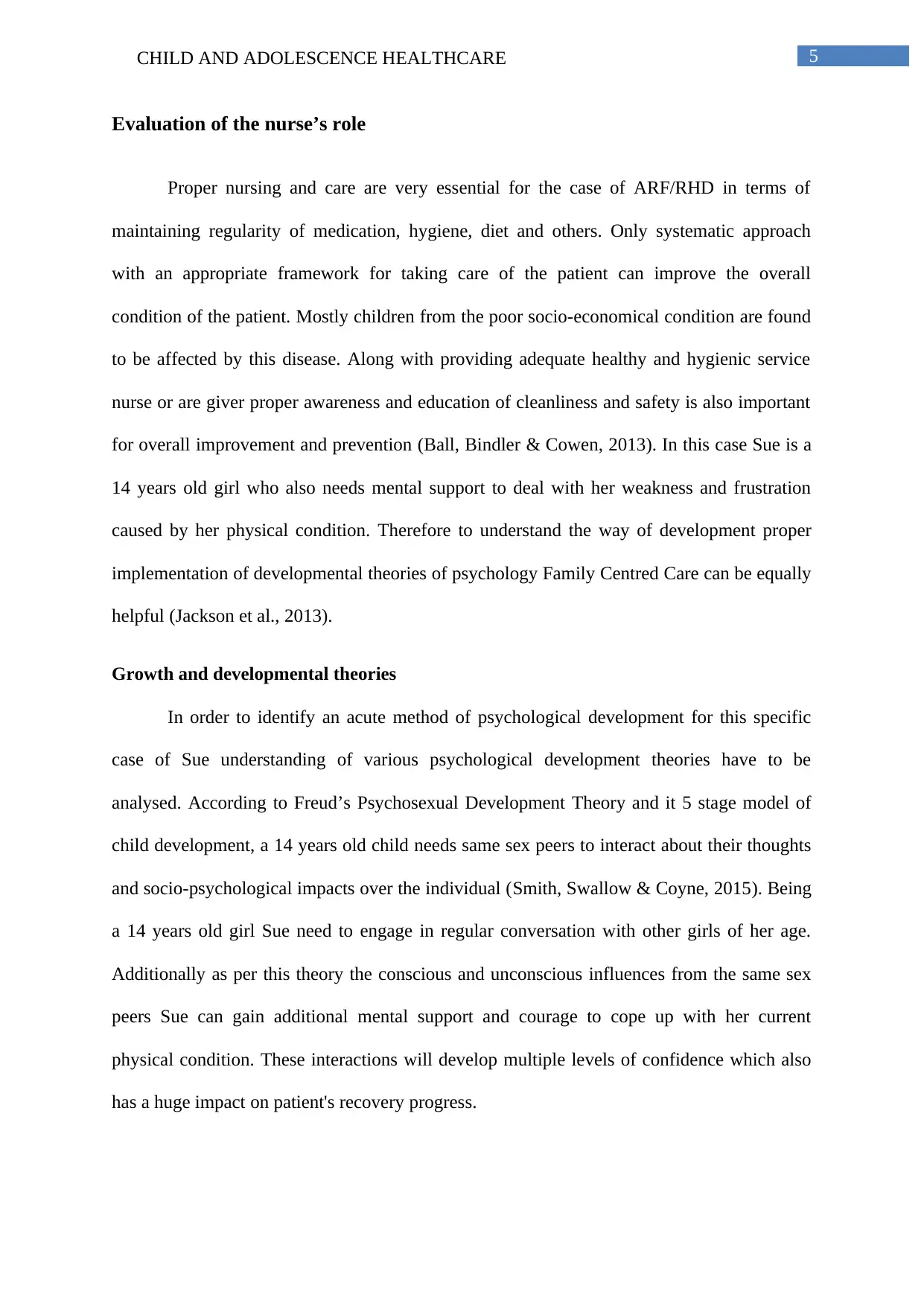
5CHILD AND ADOLESCENCE HEALTHCARE
Evaluation of the nurse’s role
Proper nursing and care are very essential for the case of ARF/RHD in terms of
maintaining regularity of medication, hygiene, diet and others. Only systematic approach
with an appropriate framework for taking care of the patient can improve the overall
condition of the patient. Mostly children from the poor socio-economical condition are found
to be affected by this disease. Along with providing adequate healthy and hygienic service
nurse or are giver proper awareness and education of cleanliness and safety is also important
for overall improvement and prevention (Ball, Bindler & Cowen, 2013). In this case Sue is a
14 years old girl who also needs mental support to deal with her weakness and frustration
caused by her physical condition. Therefore to understand the way of development proper
implementation of developmental theories of psychology Family Centred Care can be equally
helpful (Jackson et al., 2013).
Growth and developmental theories
In order to identify an acute method of psychological development for this specific
case of Sue understanding of various psychological development theories have to be
analysed. According to Freud’s Psychosexual Development Theory and it 5 stage model of
child development, a 14 years old child needs same sex peers to interact about their thoughts
and socio-psychological impacts over the individual (Smith, Swallow & Coyne, 2015). Being
a 14 years old girl Sue need to engage in regular conversation with other girls of her age.
Additionally as per this theory the conscious and unconscious influences from the same sex
peers Sue can gain additional mental support and courage to cope up with her current
physical condition. These interactions will develop multiple levels of confidence which also
has a huge impact on patient's recovery progress.
Evaluation of the nurse’s role
Proper nursing and care are very essential for the case of ARF/RHD in terms of
maintaining regularity of medication, hygiene, diet and others. Only systematic approach
with an appropriate framework for taking care of the patient can improve the overall
condition of the patient. Mostly children from the poor socio-economical condition are found
to be affected by this disease. Along with providing adequate healthy and hygienic service
nurse or are giver proper awareness and education of cleanliness and safety is also important
for overall improvement and prevention (Ball, Bindler & Cowen, 2013). In this case Sue is a
14 years old girl who also needs mental support to deal with her weakness and frustration
caused by her physical condition. Therefore to understand the way of development proper
implementation of developmental theories of psychology Family Centred Care can be equally
helpful (Jackson et al., 2013).
Growth and developmental theories
In order to identify an acute method of psychological development for this specific
case of Sue understanding of various psychological development theories have to be
analysed. According to Freud’s Psychosexual Development Theory and it 5 stage model of
child development, a 14 years old child needs same sex peers to interact about their thoughts
and socio-psychological impacts over the individual (Smith, Swallow & Coyne, 2015). Being
a 14 years old girl Sue need to engage in regular conversation with other girls of her age.
Additionally as per this theory the conscious and unconscious influences from the same sex
peers Sue can gain additional mental support and courage to cope up with her current
physical condition. These interactions will develop multiple levels of confidence which also
has a huge impact on patient's recovery progress.

6CHILD AND ADOLESCENCE HEALTHCARE
According to Erikson’s Stages of Psychosocial Development Theory, the overall
psychological development from both conscious and unconscious aspect, the impact of
external factors like parents, society, peers and others have a huge impact on the development
of an individual from childhood to adulthood. As per the theory every person needs to go
through 7 developmental stages to complete lifecycle. Sue fits in the 5th stage o development
of this psychosocial development theory (Dweck, 2013). In this part of life, a person
struggles to find out self-identity by negotiating with social interactions and developing the
concept of morality and ethics. Therefore at this stage, Sue has strong bonding with his or her
family members and close friends
As per Bowlby's Attachment Theory the psychological and personality development
has a huge influence on the attachment process from the infant phase. Cognitive, behavioural,
social, emotional and other attachments with the surroundings make any individual strongly
bounded with surroundings (Gibbs, 2013). Sue has been brought up in her family with the
siblings. Therefore the emotional attachment with the family members generates a ‘contact
comfort’ which is most essential part of building mental capability to survive. To improve
Sue’s physical condition close encounter and support of her parents and siblings are very
important.
Family centred care
Family Centred Care also is known as FCC is a partnership based approach to health care,
involving patients, families and healthcare providers. In this healthcare practice, the patient is
treated along with a consistent presence of the family members. This approach is usually used
for treating child where both the child and parents and other family members are counted to
collect feedback about the updated condition and improvement of the patient (Crain, 2015).
To execute this FCC approach proper accommodation for the patient and his or her family
members are required. The effective advantages of FCC in this given situation of Sue are:
According to Erikson’s Stages of Psychosocial Development Theory, the overall
psychological development from both conscious and unconscious aspect, the impact of
external factors like parents, society, peers and others have a huge impact on the development
of an individual from childhood to adulthood. As per the theory every person needs to go
through 7 developmental stages to complete lifecycle. Sue fits in the 5th stage o development
of this psychosocial development theory (Dweck, 2013). In this part of life, a person
struggles to find out self-identity by negotiating with social interactions and developing the
concept of morality and ethics. Therefore at this stage, Sue has strong bonding with his or her
family members and close friends
As per Bowlby's Attachment Theory the psychological and personality development
has a huge influence on the attachment process from the infant phase. Cognitive, behavioural,
social, emotional and other attachments with the surroundings make any individual strongly
bounded with surroundings (Gibbs, 2013). Sue has been brought up in her family with the
siblings. Therefore the emotional attachment with the family members generates a ‘contact
comfort’ which is most essential part of building mental capability to survive. To improve
Sue’s physical condition close encounter and support of her parents and siblings are very
important.
Family centred care
Family Centred Care also is known as FCC is a partnership based approach to health care,
involving patients, families and healthcare providers. In this healthcare practice, the patient is
treated along with a consistent presence of the family members. This approach is usually used
for treating child where both the child and parents and other family members are counted to
collect feedback about the updated condition and improvement of the patient (Crain, 2015).
To execute this FCC approach proper accommodation for the patient and his or her family
members are required. The effective advantages of FCC in this given situation of Sue are:
Paraphrase This Document
Need a fresh take? Get an instant paraphrase of this document with our AI Paraphraser

7CHILD AND ADOLESCENCE HEALTHCARE
FCC can empower Sue and her families and fosters independence.
FCC can support her family in caregiving and decision making that will allow the
caregivers to keep track the psychological condition of Sue.
FCC also respects patients’ and families choices and their values, beliefs, and cultural
backgrounds that are also built on Sue and her family cooperation.
FCC allows consistent interaction and attachment between Sue and her family that
can influence her conscious and unconscious mind to build up strong physical and
mental survival capacity that can lead to quicker improvement.
In this given case scenario Sue comes from an aboriginal origin where she did not get the
adequate environment to have a physically healthy life. On the other hand, the hospital is
situated at 800km away from her house that can also cause lack of interaction between Sue
and her family members. In this situation, FCC can be very effective that also involves
patients and families in planning, delivery and evaluation of healthcare services (Barber &
Xia, 2013).
The effects of hospitalisation on the child
The hospital is situated at 800km away from her house that indicates that the distance
between her house and the hospitalisation will hinder the comfortable integration of Sue and
her family members. Both Sue and her family members can be affected psychologically by
hospitalisation of Sue.
As the result of long-distance hospitalisation Sue can face excessive depression and
anxiety being unable to maintain consistent interaction with her family members. It can also
reduce the confidence level of the patient that has a huge impact on patient's physical health
as well (Hockenberry, & Wilson, 2014). Apart from that, she belongs from aboriginal
community. Therefore detachment from her community and social environment can have a
FCC can empower Sue and her families and fosters independence.
FCC can support her family in caregiving and decision making that will allow the
caregivers to keep track the psychological condition of Sue.
FCC also respects patients’ and families choices and their values, beliefs, and cultural
backgrounds that are also built on Sue and her family cooperation.
FCC allows consistent interaction and attachment between Sue and her family that
can influence her conscious and unconscious mind to build up strong physical and
mental survival capacity that can lead to quicker improvement.
In this given case scenario Sue comes from an aboriginal origin where she did not get the
adequate environment to have a physically healthy life. On the other hand, the hospital is
situated at 800km away from her house that can also cause lack of interaction between Sue
and her family members. In this situation, FCC can be very effective that also involves
patients and families in planning, delivery and evaluation of healthcare services (Barber &
Xia, 2013).
The effects of hospitalisation on the child
The hospital is situated at 800km away from her house that indicates that the distance
between her house and the hospitalisation will hinder the comfortable integration of Sue and
her family members. Both Sue and her family members can be affected psychologically by
hospitalisation of Sue.
As the result of long-distance hospitalisation Sue can face excessive depression and
anxiety being unable to maintain consistent interaction with her family members. It can also
reduce the confidence level of the patient that has a huge impact on patient's physical health
as well (Hockenberry, & Wilson, 2014). Apart from that, she belongs from aboriginal
community. Therefore detachment from her community and social environment can have a
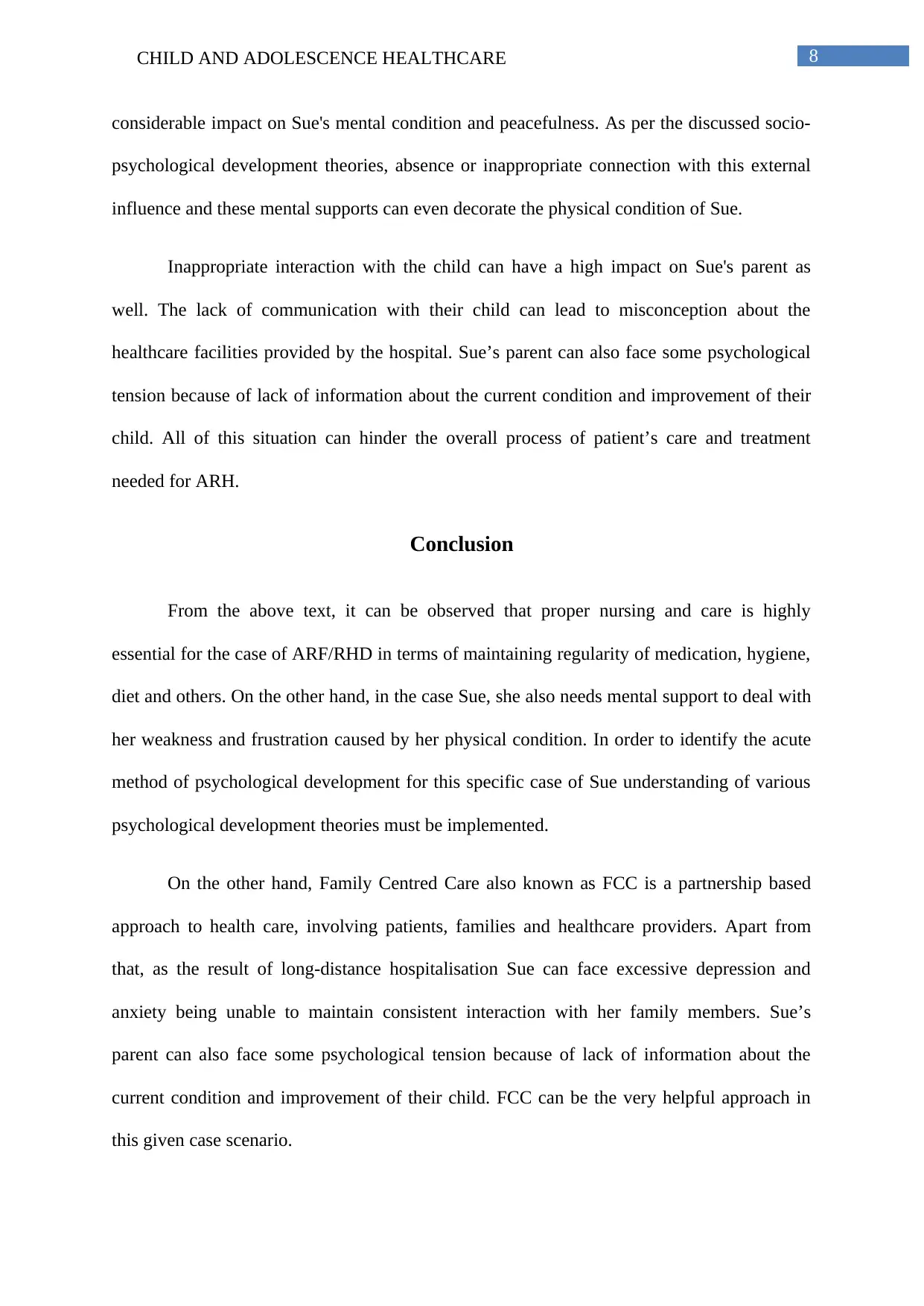
8CHILD AND ADOLESCENCE HEALTHCARE
considerable impact on Sue's mental condition and peacefulness. As per the discussed socio-
psychological development theories, absence or inappropriate connection with this external
influence and these mental supports can even decorate the physical condition of Sue.
Inappropriate interaction with the child can have a high impact on Sue's parent as
well. The lack of communication with their child can lead to misconception about the
healthcare facilities provided by the hospital. Sue’s parent can also face some psychological
tension because of lack of information about the current condition and improvement of their
child. All of this situation can hinder the overall process of patient’s care and treatment
needed for ARH.
Conclusion
From the above text, it can be observed that proper nursing and care is highly
essential for the case of ARF/RHD in terms of maintaining regularity of medication, hygiene,
diet and others. On the other hand, in the case Sue, she also needs mental support to deal with
her weakness and frustration caused by her physical condition. In order to identify the acute
method of psychological development for this specific case of Sue understanding of various
psychological development theories must be implemented.
On the other hand, Family Centred Care also known as FCC is a partnership based
approach to health care, involving patients, families and healthcare providers. Apart from
that, as the result of long-distance hospitalisation Sue can face excessive depression and
anxiety being unable to maintain consistent interaction with her family members. Sue’s
parent can also face some psychological tension because of lack of information about the
current condition and improvement of their child. FCC can be the very helpful approach in
this given case scenario.
considerable impact on Sue's mental condition and peacefulness. As per the discussed socio-
psychological development theories, absence or inappropriate connection with this external
influence and these mental supports can even decorate the physical condition of Sue.
Inappropriate interaction with the child can have a high impact on Sue's parent as
well. The lack of communication with their child can lead to misconception about the
healthcare facilities provided by the hospital. Sue’s parent can also face some psychological
tension because of lack of information about the current condition and improvement of their
child. All of this situation can hinder the overall process of patient’s care and treatment
needed for ARH.
Conclusion
From the above text, it can be observed that proper nursing and care is highly
essential for the case of ARF/RHD in terms of maintaining regularity of medication, hygiene,
diet and others. On the other hand, in the case Sue, she also needs mental support to deal with
her weakness and frustration caused by her physical condition. In order to identify the acute
method of psychological development for this specific case of Sue understanding of various
psychological development theories must be implemented.
On the other hand, Family Centred Care also known as FCC is a partnership based
approach to health care, involving patients, families and healthcare providers. Apart from
that, as the result of long-distance hospitalisation Sue can face excessive depression and
anxiety being unable to maintain consistent interaction with her family members. Sue’s
parent can also face some psychological tension because of lack of information about the
current condition and improvement of their child. FCC can be the very helpful approach in
this given case scenario.

9CHILD AND ADOLESCENCE HEALTHCARE
References
Ball, J. W., Bindler, R. C., & Cowen, K. J. (2013). Child health nursing. Prentice Hall.
Barber, B. K., & Xia, M. (2013). The centrality of control to parenting and its effects.
Coyne, I. (2015). Families and health‐care professionals' perspectives and expectations of
family‐centred care: hidden expectations and unclear roles. Health
expectations, 18(5), 796-808.
Crain, W. (2015). Theories of development: Concepts and applications. Psychology Press.
Dweck, C. S. (2013). Self-theories: Their role in motivation, personality, and development.
psychology press.
Gibbs, J. C. (2013). Moral development and reality: Beyond the theories of Kohlberg,
Hoffman, and Haidt. Oxford University Press.
Hockenberry, M. J., & Wilson, D. (2014). Wong's nursing care of infants and children-E-
book. Elsevier Health Sciences.
Jackson, G. L., Powers, B. J., Chatterjee, R., Bettger, J. P., Kemper, A. R., Hasselblad, V., ...
& Gray, R. (2013). The patient-centered medical home: a systematic review. Annals
of internal medicine, 158(3), 169-178.
Kumar, R. K., & Tandon, R. (2013). Rheumatic fever & rheumatic heart disease: The last 50
years. The Indian journal of medical research, 137(4), 643.
Ralston, S. L., Lieberthal, A. S., Meissner, H. C., Alverson, B. K., Baley, J. E., Gadomski, A.
M., ... & Phelan, K. J. (2014). Clinical practice guideline: the diagnosis, management,
and prevention of bronchiolitis. Pediatrics, 134(5), e1474-e1502.
References
Ball, J. W., Bindler, R. C., & Cowen, K. J. (2013). Child health nursing. Prentice Hall.
Barber, B. K., & Xia, M. (2013). The centrality of control to parenting and its effects.
Coyne, I. (2015). Families and health‐care professionals' perspectives and expectations of
family‐centred care: hidden expectations and unclear roles. Health
expectations, 18(5), 796-808.
Crain, W. (2015). Theories of development: Concepts and applications. Psychology Press.
Dweck, C. S. (2013). Self-theories: Their role in motivation, personality, and development.
psychology press.
Gibbs, J. C. (2013). Moral development and reality: Beyond the theories of Kohlberg,
Hoffman, and Haidt. Oxford University Press.
Hockenberry, M. J., & Wilson, D. (2014). Wong's nursing care of infants and children-E-
book. Elsevier Health Sciences.
Jackson, G. L., Powers, B. J., Chatterjee, R., Bettger, J. P., Kemper, A. R., Hasselblad, V., ...
& Gray, R. (2013). The patient-centered medical home: a systematic review. Annals
of internal medicine, 158(3), 169-178.
Kumar, R. K., & Tandon, R. (2013). Rheumatic fever & rheumatic heart disease: The last 50
years. The Indian journal of medical research, 137(4), 643.
Ralston, S. L., Lieberthal, A. S., Meissner, H. C., Alverson, B. K., Baley, J. E., Gadomski, A.
M., ... & Phelan, K. J. (2014). Clinical practice guideline: the diagnosis, management,
and prevention of bronchiolitis. Pediatrics, 134(5), e1474-e1502.
Secure Best Marks with AI Grader
Need help grading? Try our AI Grader for instant feedback on your assignments.
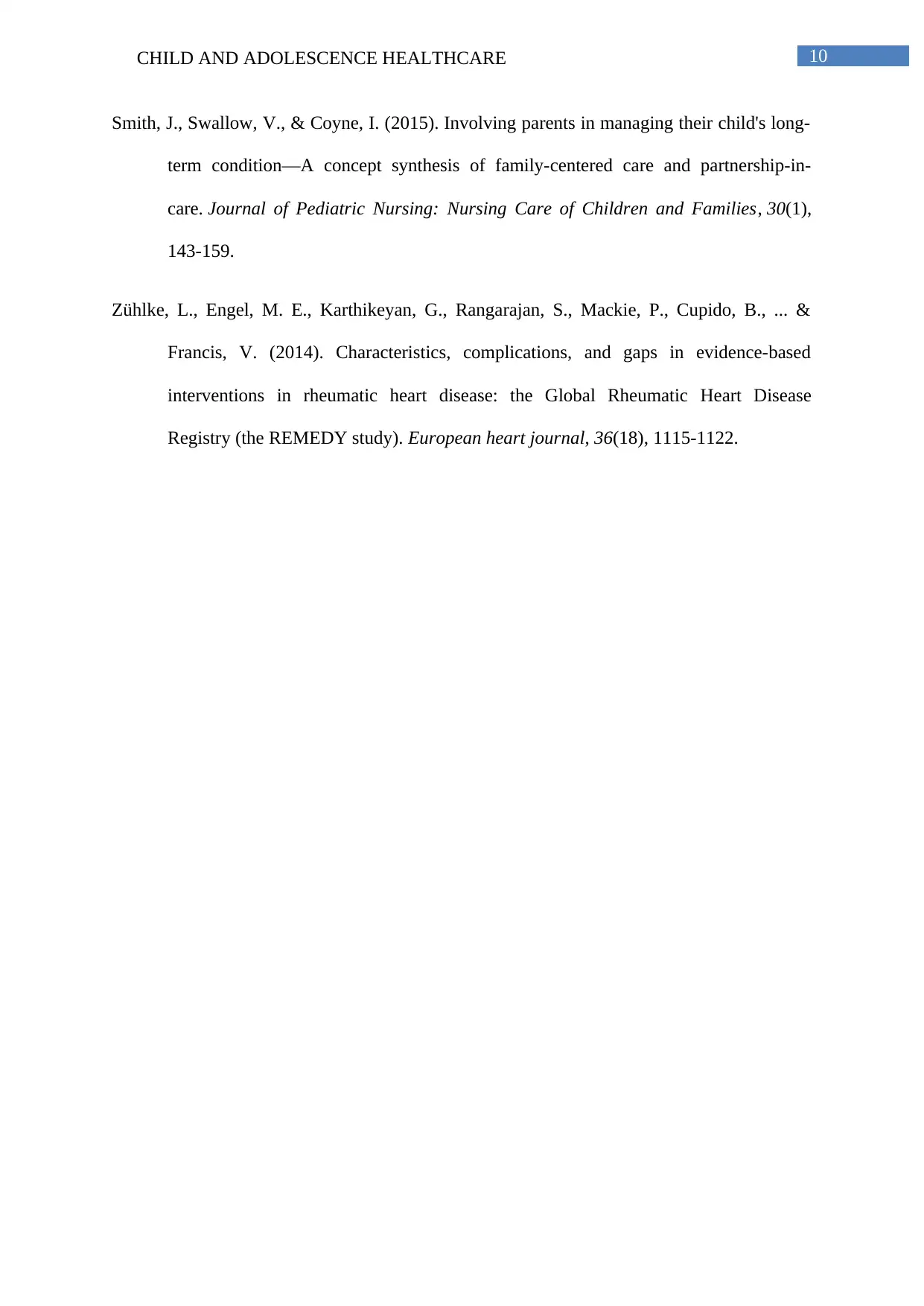
10CHILD AND ADOLESCENCE HEALTHCARE
Smith, J., Swallow, V., & Coyne, I. (2015). Involving parents in managing their child's long-
term condition—A concept synthesis of family-centered care and partnership-in-
care. Journal of Pediatric Nursing: Nursing Care of Children and Families, 30(1),
143-159.
Zühlke, L., Engel, M. E., Karthikeyan, G., Rangarajan, S., Mackie, P., Cupido, B., ... &
Francis, V. (2014). Characteristics, complications, and gaps in evidence-based
interventions in rheumatic heart disease: the Global Rheumatic Heart Disease
Registry (the REMEDY study). European heart journal, 36(18), 1115-1122.
Smith, J., Swallow, V., & Coyne, I. (2015). Involving parents in managing their child's long-
term condition—A concept synthesis of family-centered care and partnership-in-
care. Journal of Pediatric Nursing: Nursing Care of Children and Families, 30(1),
143-159.
Zühlke, L., Engel, M. E., Karthikeyan, G., Rangarajan, S., Mackie, P., Cupido, B., ... &
Francis, V. (2014). Characteristics, complications, and gaps in evidence-based
interventions in rheumatic heart disease: the Global Rheumatic Heart Disease
Registry (the REMEDY study). European heart journal, 36(18), 1115-1122.
1 out of 11
Related Documents
Your All-in-One AI-Powered Toolkit for Academic Success.
+13062052269
info@desklib.com
Available 24*7 on WhatsApp / Email
![[object Object]](/_next/static/media/star-bottom.7253800d.svg)
Unlock your academic potential
© 2024 | Zucol Services PVT LTD | All rights reserved.





